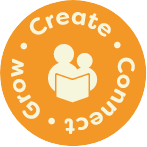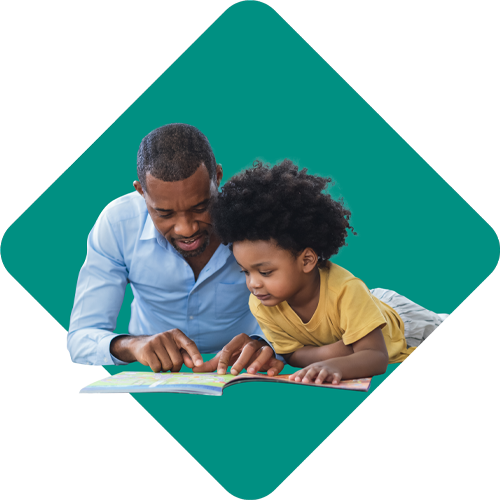Why We Believe in We Can Books

Learning to read on paper-based books featuring familiar images they love will keep a child’s attention while they make the connections between images and sounds, words and meaning that are so crucial to successful early reading.
We Can Books helps parents and grandparents of children aged 3-5 give those children a personalized, effective head start on reading skills. Poor reading skills can lead to a life of difficulties, while early reading skills provide an edge that can lead to lifelong success.
Using We Can Books’ blended phonics system with photos taken from the young reader’s own world, parents and grandparents can create heirloom-quality, one-of-a-kind books that children will want to open again and again, as they see themselves and familiar images on the page and learn to read with ease and excitement, while sharing the unforgettable adventure with an adult they love.
Importance of reading skills to life success
“Children’s opportunities are seriously compromised if they don’t learn to read and spell. They are much more likely to drop out of school early, be unemployed, suffer ill health and get on the wrong side of the law.”
– Pamela Snow, The Way We Teach Most Children to Read Sets Them Up to Fail
5 February 2015
Good readers have brighter futures than poor readers, and the die is cast as early as fourth grade. Children who are not reading at a proficient level by the fourth grade are four times more likely to drop out of high school.
- More than one third of all juvenile offenders read below the fourth-grade level.
- Among adults at the lowest level of literacy proficiency, 43% live in poverty. Among adults with strong literacy skills, only 4% live in poverty
- An adult without a high school diploma earns 42% less than one with a diploma.
- Those who cannot read at grade level by the start of fourth grade are four times more likely to drop out of high school.

Importance of phonics-based learning for reading success
In 2014 the California Department of Education stated “Ensuring that children know how to decode regularly spelled one-syllable words by mid-first grade is crucial.” It goes on to say that “Children need to be phonemically aware (especially able to segment and blend phonemes).” The skills of segmenting and blending phonemes are a central aspect of synthetic phonics.
– National Institute for Literacy
Government-funded documents have shown that phonics instruction is helpful for all students, harmful for none, and crucial for some. A recent brain research study out of Stanford explained how beginning readers who focus on letter–sound relationships, or phonics, instead of trying to learn whole words, increase activity in the area of the brain best wired for reading.
– International Literacy Association, 2019 Literacy Leadership Brief
But which type of phonics works best? The Clackmannanshire study provides convincing evidence for synthetic (blended) phonics. This starts from just a few sounds and letters in short words, and systematically adds and practices more sounds, spellings and syllable types, until children can read well enough to independently tackle the “real books” adults have been reading them.
Clackmannanshire is a disadvantaged area of Scotland, but by the end of primary school the children using this program were three years ahead of the national average on word reading, 21 months ahead on spelling and five months ahead on reading comprehension.
In 2005, Australia’s National Inquiry into Teaching Reading recommended that young children should be provided with systematic, explicit and direct phonics instruction, and that teachers be equipped to provide this. Similar inquiries in the US and UK agreed.
– Pamela Snow, The Way We Teach Most Children to Read Sets Them Up to Fail
5 February 2015

Screens and the development of the young brain
A new study scanned the brains of children 3 to 5 years old and found those who used screens more than the recommended one hour a day without parental involvement had lower levels of development in the brain’s white matter – an area key to the development of language, literacy and cognitive skills.
– CNN.com, MRIs show screen time linked to lower brain development in preschoolers
4 November 2019
Early data from a landmark National Institutes of Health (NIH) study that began in 2018 indicates that children who spent more than two hours a day on screen-time activities scored lower on language and thinking tests, and some children with more than seven hours a day of screen time experienced thinning of the brain’s cortex, the area of the brain related to critical thinking and reasoning.
– Jennifer F. Cross, M.D., What Does Too Much Screen Time Do to Children’s Brains?

Evidence increases for reading on paper instead of screens
Why students don’t read as well on screens is a fascinating question. Some experts think the glare and flicker of screens tax the brain more than paper. Others argue that spatial memory for the location of a passage or a chart on a physical paper page can help a student recall information.
– Virginia Clinton, Reading from paper compared to screens: A systematic review and meta‐analysis
13 January 2019
Researchers Schugar et. al (2013) worked with middle-grade students and found that those who read print comprehended more than those who read an eBook on an iPad. This is further confirmed by Reich, Yau and Warschauer in their 2016 report on using tablet-based eBooks with very young children (0 to 2 years), which comments that enhanced eBooks with sounds, animations, and games can distract children and reduce learning.
– Lisa Alcott, Reading on-screen vs reading in print: What’s the difference for learning?
10 October 2019

